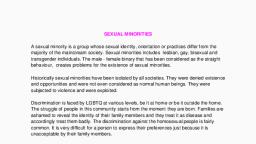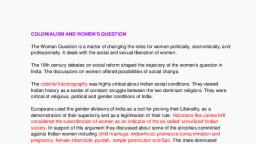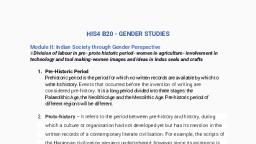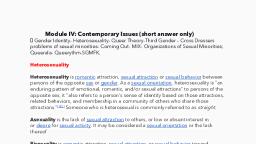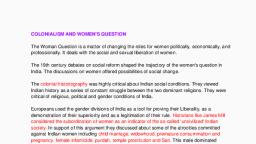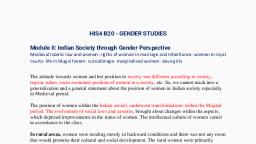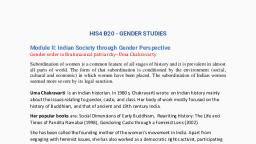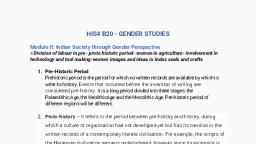Page 1 :
HIS4 B20 - GENDER STUDIES, Module II: Indian Society through Gender Perspective, Women in Buddhism and Jainism, Women in Buddhism, The 6th century BCE in the Indian subcontinent was a dynamic period. It witnessed, several changes that had long-lasting consequences. Firstly, the period witnessed the, rise of territorial kingdoms known as Mahajanapadas. Secondly, the Indian, subcontinent witnessed the rise of two philosophies; Buddhism and Jainism. Finally,, the Vedic philosophies acquired a firm shape further entrenching into people’s social, lives., Several scholars have analyzed the condition of women in the heterodox sects of, Buddhism and Jainism. Uma Chakravarti, I.B.Horner are some among them. Horner, argues for a two way relationship between women and Buddhism. On the one hand, she accepts that Buddhism opened a new space for women at the same time she, suggests that women not only shaped the contents of that space but they redefined, Buddhism to a certain extent., During the 6th century BC, the status of women in the Indian society was determined, by the patriarchal caste system and was very miserable. Gautama Buddha tried to, bring changes in the social conditions. Buddhism in its initial years asserted that, Nirvana (highest goal), was possible for women and so created the Buddhist Sangha., On one occasion when the king of Kosala was having a conversation with the Buddha,, the news was brought to him that his queen, Mallika, had borne him a daughter., Noticing that the king was distressed, the Buddha remarked, “Do not be perturbed O, King, a female child may prove even a better offspring than a male, for she may grow, up wise and virtuous.”, During this period women came to enjoy more equality and greater respect than ever, given to them, although the activities where confined within certain spheres are, mainly domestic social and religious their position in general began to improve. The, Buddha's advice to the King Pasenadi of Kosala, who was a close devotee of his,, clearly shows that Buddhism does not consider the birth of a daughter as a cause for, worry and despair. He preached his teachings to both men and women without any, , MAMOC HISTORY, , 1
Page 2 :
discrimination. He was of the view that women are equally intelligent and capable to, shoulder any responsibility entrusted to them with efficiency., Women were given the freedom to marry the person of their own choice. As a, mother, she was honoured, respected. A widow was allowed to participate in all the, domestic festivities and not considered an ill omen any longer., Buddhism does not restrict either the educational opportunities of women or their, religious freedom. The Buddhist texts records several eminent Bhikkhunis (Female, Budhist Bhikshu), who were very learned and who were experts in preaching the, Dhamma. Dhammadinna, Khema, Uppalavanna were Bhikkhunis. Yasodhara, wife of, Buddha, had given up all luxury and was living a very simple life after the departure of, Gautama from the palace of Kapilavastu. She later became a Bhikkhuni., There are many Upasikas like Visakha, Sumana, Malliki, Khujjuttara, Sujata and, Suppiya who had important roles for the spread of Buddhism. Buddhist women had, been credited for their contributions to the growth of literature. They wrote drama,, songs and prayers in Palli language. Therigatha is a unique contribution of the, Buddhist women to the history of Indian poetic literature., Despite the fact that the Buddha elevated the status of women, he was practical in his, observations and advice given from time to time in that he realised the social and, physiological differences that existed between men and women., The Buddhist texts shed lights to the contributions of women in early Buddhism. They, contain several references to learned nuns. The Samyutta Nikaya refers to Khema who, astonished King Prasenjit that he bowed to her., Critical reading of women in Budhism, On the other hand, The Buddhist texts reflect a contradictory picture;, The Budhist Texts represent the stereotypical understanding of women whose life, was supposed to revolve around their husbands. The texts also reflected that women, were inferior, sinful, and a source of contamination to men. Buddha in the beginning, was not ready to admit women into the Sangha., This episode is narrated in the Vinaya Pitaka. It was only after influence by his Aunt, Mahapajapati Gotami and disciple Ananda that Buddha agreed to admit women but, added eight other harsh conditions to the nuns. These included that if a nun even if, she is ordained for 100 years will have to rise up from her seat and greet the monk, (ഒരു കന്യാസ്ത്രീ 100 വർഷം സന്യാസം സവീകരിച്ചാലും അവളുടെ ഇരിപ്പിെത്തിൽ ന്ിന്ന് എഴുന്നന്നറ്റ്, , MAMOC HISTORY, , 2
Page 3 :
under no circumstance she has to abuse a monk, (ഒരു കാരണവശാലും സന്യാസിമാടര െീരപരെരുത്), etc., സന്യാസിടെ അഭിവാദ്യം ടെന്നേണ്ടരാണ്),, , Buddhist tradition also records that after the death of Buddha, when the compilation, of Buddhist teachings was going on, Ananda was made to admit the differences, during Buddha’s, life, one of which was admitting women in the Sangha. The Vinaya Pitaka also, suggests the prediction of Buddha that since the Sangha has admitted women, the, doctrine would decline in 500 instead of 1000 years. The doctrine also argued that, though women can achieve salvation, their capability of attaining Buddhahood, without being born as a man was not accepted., Women in Jainism, Jainism is a religion of religious equality, devoted to recognising the rights of all, living creatures. So it accepts that women are able to play their part for attaining, liberation. But for some Jains a woman's very femaleness creates spiritual inequality., There are two major divisions in Jains as Digambara and Swetambara. The attitude of, each sects are different., Considering the evil practices and negative attitude of men towards women,, Mahavira freed them from indignation for their own progress in all walks of life. Some, reservations had, of course to be observed due to the slight physical incapability of, women. Hence, some special rules were prescribed for nuns. Though they used to be, heads of their units as Pravartini and Ganavacchedini, similar to Acarya and, Upadhyaya, there were entirely responsible to the Acaryas, Candana, Puspacula,, Subarata, and other well-known nuns of long ago, are referred to this context. Even, the patriarchal form of the society was developed and nuns were treated as slightly, inferior to monks in certain respects. This however, does not hold women as anything, less than human beings who, like all souls, have the right and capability to attain, salvation., Women in Jainism are treated within the same code of ethics as that is prescribed for, men. As per Jainism both men and women are supposed to play their common roles, of helping each other, working for the common welfare of all humanity, and, protecting the environment. Each is responsible for his/her moral conduct. Jainism, considers men and women as equals. In reality because of the gender stereotyping, that has taken place for thousands of years in a patriarchal society and inherent, biological differences between men and women, the roles prescribed for men and, women are different especially in a social and cultural setup., Mahavira did not keep community life as exclusive privilege of men. He also, permitted it to a be right for women. He organised his followers into four Orders, , MAMOC HISTORY, , 3
Page 4 :
monks and nuns lay men and lay women. Women were a part of Jain monastic, orders, there were several female renounces. One among them was Candanbala, a, female renounced during the period of Mahavira and she is said to led a order of, women., Critical reading of women in Jainism, The sects of Jainism on the other handheld debate for more than a millennium over, the position of women. The central debates were over the issue of whether women, can achieve salvation and, on clothing., Since the Digambara sect stressed giving up on clothing as it counted as a material, possession, the question of women following nudity was a matter of concern. The, female anatomy restricted women to undertake the rigorous ascetic life required by, the Jaina monks. For the Shvetambaras, wearing or not wearing clothes was optional., The monks and nuns took the same vows and were on par with each other., Similar to the Buddhist Sangha, the Jaina order also practiced inequality. No matter, how senior a nun was, she had to pay respect to a junior monk. On the debate over, salvation, the Digambaras hold that a woman can achieve salvation only if she had, been born as a male in one of the births. The Shvetambaras agree that women can, achieve salvation., Another argument is that because a woman's nature is to care for children and other, dependents, she will find it much more difficult to break free from these earthly, attachments, and unless she does this, she cannot achieve liberation., A nun in Jainism is known as Aryika and also as Sadhvi. The aryika does not visit, the, house of a layman alone or without purpose. She is allowed a single robe which is to, cover her entire body, from head to foot. The aryika is not qualified, as such, to, aspire for the pandita-pandita death, but she expects to reach it, from a male body, in, a subsequent incarnation. The reason for this is to be found in the fact that a female, body is not like a male body in all respects, so that salvation is not possible for a, female from the female form., Assessment:, The question that arises in the mind of any present-day reader would be on how to, assess these 6th-5th century BCE traditions?, , MAMOC HISTORY, , 4
Page 5 :
The general understanding that Buddhism and Jainism preached for equality can be, contradicted. However, an anachronistic view of History would only do harm. These, philosophies that took shape in 6th century India have to be assessed as per the, social standards of that particular time. Despite the initial reluctance and strict norms, for women, the heterodox philosophies opened up spaces for spiritual aspirations of, women and the women in the Sangha were also responsible for the spreading of, Buddhist and Jaina ideas among the common people., A number of books have been written on the changing status of women in Hindu and, Islamic societies, but with regard to women in Buddhism, ever since the distinguished, Pali scholar, Miss I.B. Horner, wrote her book on Women under Primitive Buddhism,, as far back as 1930, very little interest has been taken in the subject., Bernard Faure and Miranda Shaw are in agreement that Buddhist studies are in its, infancy in terms of addressing gender issues. Shaw gave an overview of the situation, in 1994, “In the case of Indo-Tibetan Buddhism some progress has been made in the, areas of women in early Buddhism, monasticism and Mahayana Buddhism. Two, articles have seriously broached the subject of women in Indian tantric Buddhism,, while somewhat more attention has been paid to Tibetan nuns and lay yoginis”., (Shaw, Miranda, Passionate Enlightenment: Women in Tantric, Buddhism. New Jersey: Princeton University Press, 1994, p.4), Buddhism rose as a protest against the steadily rigidifying Brahmanism. In the postVedic period the dominance of rituals increasingly grew, thereby giving indomitable, power to the Brahmins. Buddhism emphasised the superfluity of any intermediary, between God and man and further opened the portals of religion to all human beings, without any distinction., There is not the slightest doubt that the Buddha was the first religious teacher who, gave women equal and unfettered opportunities in the field of spiritual development., Although he had pointed out on several occasions the natural tendencies and, weakness of women, he had also given due credit to their abilities and capabilities., He truly paved the way for women to lead a full religious life. They were able to, develop and purify their minds and realise the bliss of Nibbana just as men were. The, testimonies of the Theris (Nuns) in the days of the Buddha speak amply to this fact., Gautama Buddha permitted women to join his monastic community and fully, participate in it, although there were certain provisos or garudhammas. As Susan, Murcott comments, “The nun’s sangha or bhikkhuni sangha - the Order of Nuns – was, a radical experiment of his time that truly opened to women new avenues of culture, and social service and ample opportunities for public life”(Murcott, Susan, 1991, p.4)., , MAMOC HISTORY, , 5





